Maytas Hub Learner / Module Progress Calculation
The following rules are used when calculating the progress of a learner:
- A module is always considered as 100% completed once a completion date is entered.
-
The relative percentage field in the module editor can be used to give a particular module a weighting. This can be defined at any or all levels of the qualification (i.e. at the qualification level, unit level or element level). If no relative percentage values are entered, the default settings in the system config table for each qualification type are used. The weightings do not need to be percentages. For example, if a qualification was made up of four units, values of 10, 10, 10 and 20 could be entered.
Important: If one module that is part of another module is given a relative percentage value, all other modules that make up the containing module should also be given a value. An empty value or a value of zero would mean the module does not count towards the progress calculation of the containing module.
- For modules that have evidence attached (e.g. Knowledge, Range and Performance Criteria), the progress is calculated by using the amount of evidence and the type of evidence that are required for the module and the amount and type of evidence that have been attained. This can be specified at the module level. Default settings in the system config table will be used for these values if none are present at the module level.
- Calculation of progress is cascaded up throughout the qualification or framework to obtain the overall progress. Therefore the calculation of progress at the highest level ultimately depends on the attained evidence and any completion dates that have been entered and the weightings attached.
- The traffic light warning thresholds can be set in the system config table.
-
The defaults weightings can be set in the system config (see the How to Enter a System Config section for instructions):
- Section: Objectives
- Item: WeightQualType%
- IntegerValue: Value
Where QualType is the type of qualification (e.g. NVQ, KS or TC) and Value is the weighting value. The % at the end of the item is optional, and will apply the config to all qual types which begin with the specified qual type. For example, KS% would apply to all qual types which begin with KS. More specific items take priority if present (e.g. WeightKSCOM1 would take priority over WeightKS%).
The qual type can be entered against a module and does not necessarily have to be NVQ, KS or TC. For example, you could enter a qual type of ABC against a module and then set up a system config for WeightABC%.
The following are used in the absence of config settings:
| QualType | Weighting Value |
|---|---|
| % | 50 |
| KS% | 10 |
| TC | 20 |
| NVQ | 50 |
| VQ | 50 |
To set the traffic light thresholds:
- Select Settings on the toolbar and click System configuration.
- Click Objectives on the left (under Maytas Hub (Online and Offline)).
- Tick the boxes next to Set the default threshold for the number of days behind target for an amber traffic light and Set the default threshold for the number of days behind target for a red traffic light.
- Enter the threshold values in the text boxes. The defaults are 15 for amber and 30 for red.
- Click Save.
The thresholds are compared against the overall completion percentage, on the basis of 100% minus the entered value. For the defaults above, this would mean red would show for objectives on or under 70% (100 – 30), amber would show for objectives on or under 85% (100 – 15) and green would show for objectives on or above 86%.
How to Manually Enter a System Config
- In Maytas 5, go to the Support tab and click the Edit Config button.
- You will be asked to enter an authorisation code. Please contact the Maytas service desk to obtain this code.
- Once the code has been entered, insert a new record by clicking the
 button.
button. - Enter the appropriate values for the record, as described above.
- When finished, click the OK button to save your changes.
Example 1
This example will look at a learner, Jim Smith, who is taking the following objectives with the specified weightings:
| Module | Objective Type | Weighting |
|---|---|---|
| NVQ in Customer Service | NVQ | 60% |
| Customer Service Technical Certificate | TC | 20% |
| Functional Skills in English | FS | 10% |
| Functional Skills in Maths | FS | 10% |
Here are his framework completion charts:
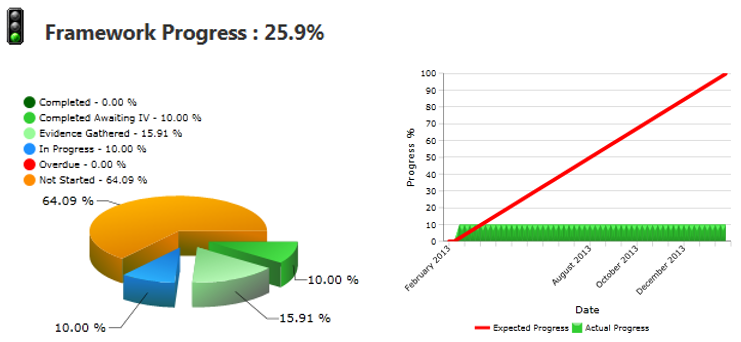
The pie chart shows that 10% has been completed and is awaiting IV (medium green) and 15.91% has evidence gathered (light green), both of which contribute to the overall framework progress of 25.9%. The pie chart also shows that 10% is in progress (i.e. units which have a start date but are not completed and have no evidence gathered) and 64.09% has not yet been started. These figures do not count towards the framework progress percentage.
The chart on the right shows the expected progress (the red line) and the actual progress (the green area). The actual progress only includes the completed percentage (the dark green area on the pie chart), which is why it is shown as 10% rather than 25.9%.
We can see how these percentages are formed by examining the individual modules:
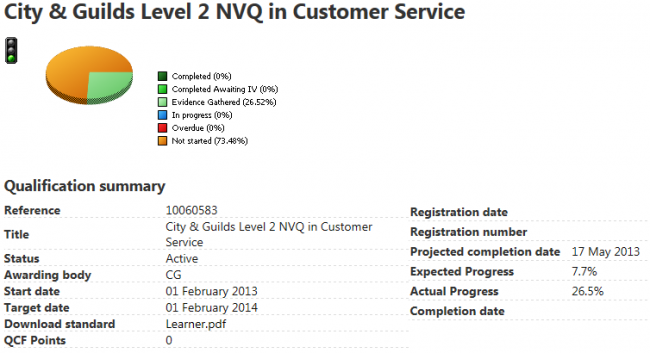
Jim’s NVQ module has been assessed and evidence has been gathered for the Knowledge criteria of the units within the module. This accounts for 26.5% of the module. None of Jim’s other modules have a status of Evidence Gathered, and therefore this is the only module which is currently forming the Evidence Gathered percentage on the overall framework. Since the module weighting for the NVQ is 60%, the overall framework percentage for Evidence Gathered is worked out as:
26.5% Evidence Gathered x 60% weighting = 15.91% Evidence Gathered
26.5% is rounded to one decimal place, which is why the overall result is 15.91% rather than 15.9%.
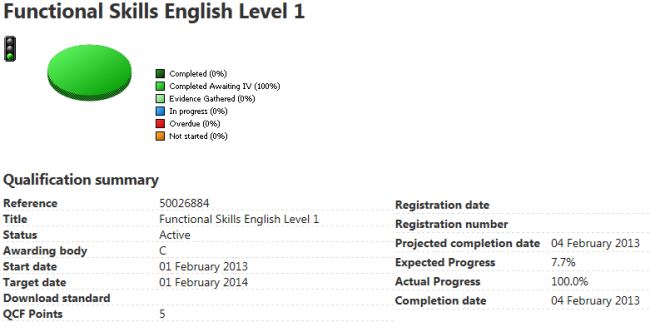
Jim’s Functional Skills module in English has a completion date, which means it is automatically set to completed awaiting IV. Since the module has a weighting of 10%, it contributes to the overall framework completion as follows:
100% Completed x 10% weighting = 10% Completed
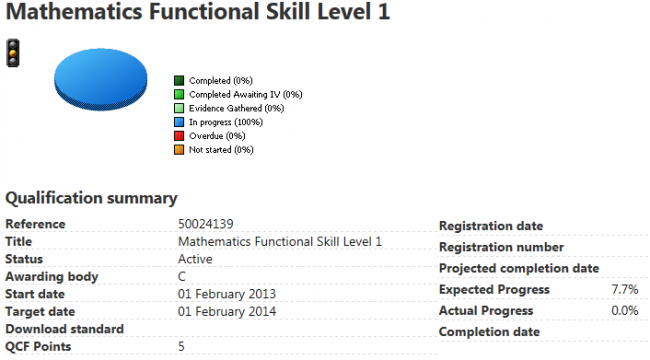
The Function Skills module in Maths has a start date for each of its units but no completion date and no evidence gathered. Therefore it is classed as In Progress. Since the module has a weighting of 10%, it contributes to the overall framework percentage for In Progress as follows:
100% In Progress x 10% weighting = 10% In Progress
The rest of Jim’s objectives have no start dates, no completion dates and no evidence gathered, which means they are classed as Not Started.
Example 2
Continuing on from example 1, Jim Smith has now completed his NVQ and it is awaiting internal verification (IV).
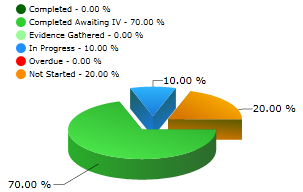
His overall framework progress is 70%. This is because his NVQ is worth 60% of the framework and his Functional Skills in English objective is worth 10%, and both are completed awaiting IV.
Next, an internal verifier accepts both units of the NVQ module in Maytas Hub and the NVQ module changes to fully completed (dark green). Note that the English Functional Skills objective is still awaiting IV.
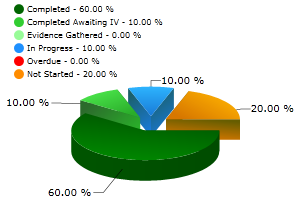
A few weeks pass and Jim has not made any further progress. He has gone past the target date for his technical certificate, which causes its status to change from Not Started to Overdue.
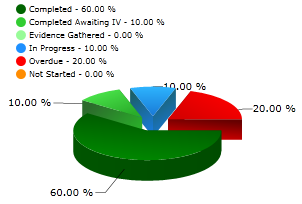
After a review with his assessor, Jim starts and completes one unit of the technical certificate. With a weighting of 20% for the framework, one complete unit out of two for the technical certificate is worth 10% towards the overall framework progress. This pushes it up to 80% (represented by the green areas below). However, note that the framework progress traffic light is red. This is because there are still overdue objectives, which automatically cause the traffic light to be red.
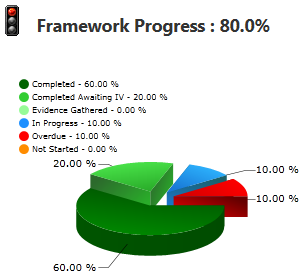
Jim completes all his remaining objectives, which sets the framework progress to 100% and the traffic light to green. However, there are still objectives which are completed awaiting IV.
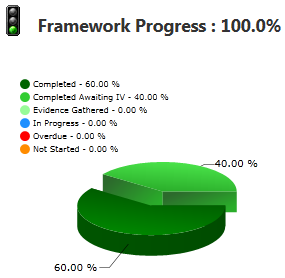
Once the remaining objectives have been accepted by an IV user, the framework is fully completed.

Expected Progress
The process for calculating expected framework progress takes many factors into account to ensure it is as accurate as possible. In broad terms, the process works out the expected progress at various points throughout the framework based on each base module and unit and its weighting. These progress stages are then consolidated to calculate the current overall expected framework progress.
Progress Stages
The starting progress stage uses the minimum start date from all the objectives in the framework. Each progress stage after that is taken from the target date of each base module and unit. Please note that objectives without a target date are ignored. The below tables show an example set of objectives and the resulting progress stages:
| Objective | Type | Start Date | Target Date |
|---|---|---|---|
| A | Module | 10/02/2016 | 01/03/2016 |
| A.1 | Unit | 10/02/2016 | 01/03/2016 |
| A.2 | Unit | 10/02/2016 | 01/03/2016 |
| B | Module | 02/02/2016 | 15/03/2016 |
| B.1 | Unit | 01/03/2016 | 15/03/2016 |
| B.2 | Unit | 01/03/2016 | 12/04/2016 |
| B.3 | Unit | 01/03/2016 | 25/04/2016 |
| Progress Stage | Date |
|---|---|
| 1 | 02/02/2016 |
| 2 | 01/03/2016 |
| 3 | 15/03/2016 |
| 4 | 12/04/2016 |
| 5 | 25/04/2016 |
Note how the earliest start date is used for stage 1, and how objectives with the same target date are consolidated into one progress stage.
Stage Weighting
Next, the weighting at each stage is determined. This is taken from the relative percentage of each objective if entered (including values of 0). If no relative percentage is entered, the qual type weighting is used for base modules (units do not use the qual type weighting and so will only use the relative percentage). See the example relative percentages and qual type weightings below, and how these affect the weighting at each stage:
| Objective | Type | Target Date | Relative % | Qual Type Weighting |
|---|---|---|---|---|
| A | Module | 01/03/2016 | 20 | 30 |
| A.1 | Unit | 01/03/2016 | ||
| A.2 | Unit | 01/03/2016 | ||
| B | Module | 15/03/2016 | 0 | 20 |
| B.1 | Unit | 15/03/2016 | ||
| B.2 | Unit | 12/04/2016 | 25 | |
| B.3 | Unit | 25/04/2016 | 5 | |
| C | Module | 25/04/2016 | 50 |
| Progress Stage | Date | Weighting |
|---|---|---|
| 1 | 02/02/2016 | 0 |
| 2 | 01/03/2016 | 20 |
| 3 | 15/03/2016 | 0 |
| 4 | 12/04/2016 | 25 |
| 5 | 25/04/2016 | 55 |
The first progress stage always has a weighting of 0.
For stage 2, A.1 and A.2 have neither a relative percentage or a qual type weighting, so they do not factor into the stage weighting. Since module A has the same target date as its units, the relative percentage of 20 is used for stage 2.
For stage 3, which consolidates objectives B and B.1, note that the relative percentage on B is used even though zero is entered. B1 has no relative percentage entered, therefore the overall weighting for stage 3 is 0. If, however, the relative percentage was not entered against B, the qual type weighting of 20 would be used and the overall weighting for stage 3 would be 20.
Stage 4 uses the relative percentage of 25 for B.2.
Stage 5 consolidates B.3 and C. Note the qual type weighting of 50 is used for C because no relative percentage is entered.
Module and Unit Progress
Before the expected progress at each stage can be determined, the expected progress for each module must be calculated, and this in turn is derived from unit progress.
Unit Progress
The expected progress for each unit is calculated as follows:
- If the unit target date is on or before the progress stage date, the expected unit progress is 100%.
- If the unit start date is after the progress stage date, the expected unit progress is 0%.
-
Otherwise (i.e. if the stage date falls between the unit start and target date), the unit progress is calculated as:
Days between unit start date and stage date
/
Days between unit start date and unit target date
Module Progress
The expected progress for each module is calculated first by working out several variables:
- RP - the sum of relative percentages for each unit within the module
- EP - the sum of expected progress for each unit within the module
- P - the sum of (unit relative percentage x unit expected progress)
If RP is greater than 0, the calculation for expected module progress is P / RP.
If RP is 0, the calculation for expected module progress is EP / number of units in the module.
If the module has no units, the expected module progress uses the same logic as with unit progress (detailed above), only for the module.
Expected Progress at Each Stage
Once the progress for each module has been determined, the progress at each stage can be calculated. The following variables are used:
- RP - the sum of relative percentages for each module
- EP - the sum of expected progress for each module
- P - the sum of (module relative percentage x module expected progress)
If RP is greater than 0, the calculation for expected progress at the stage date is P / RP.
If RP is 0, the calculation for expected progress at the stage date is EP / number of modules.
Current Total Progress
The overall expected framework progress at present is determined using the following variables:
- S1 - the progress stage immediately on or before the current date
- S2 - the first progress stage after the current date
- P - days between S1 and current date / days between S1 and S2 (i.e. how far we are between the two stages)
The overall framework progress is calculated as ((progress for S2 - progress for S1) x P) + progress for S1.
Progress Traffic Lights
Each learner has a framework progress traffic light which gives a visual indication of whether or not they are on schedule.

The traffic light colour (green, amber, red or blue) is determined by the number of days the learner is behind target, which is compared to thresholds for the colours. The number of days behind target is defined as the difference in days between the projected framework completion date and the framework expected completion date
The traffic light thresholds can be set in the system configuration options:
- Select Settings on the toolbar.
- Click System configuration.
- Click Objectives on the left (under the Maytas Hub (Online and Offline) header).
-
The two relevant configs are Set the default threshold for the number of days behind target for an amber traffic light and Set the default threshold for the number of days behind target for a red traffic light.
Tick the box next to each config and enter the threshold numbers (in days behind target).
- Click Save.
If these configs are not set, defaults of 15 days for amber and 30 days for red are used. The below table shows when each colour would be used with the default thresholds:
| Days behind target | Colour |
|---|---|
| 0 to 14 | Green |
| 15 to 29 | Amber |
| 30 or more | Red |
The blue traffic light is used if the days behind target cannot be calculated, which is generally due to missing framework dates.